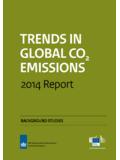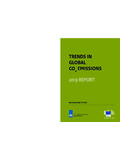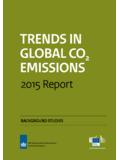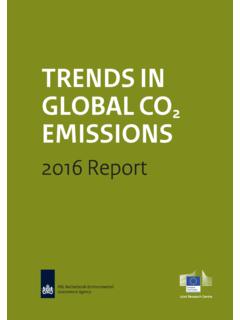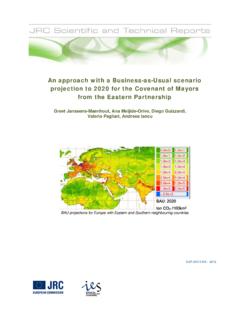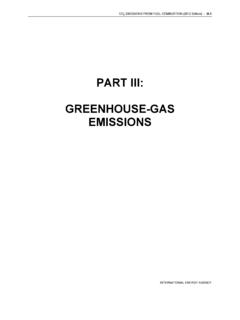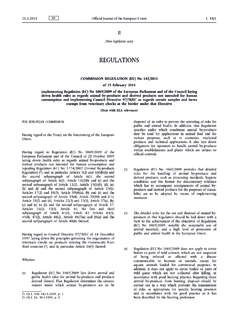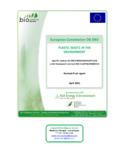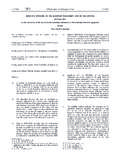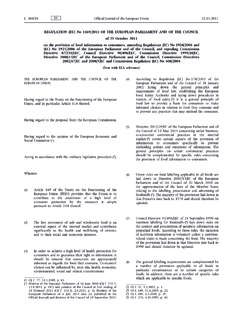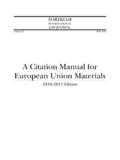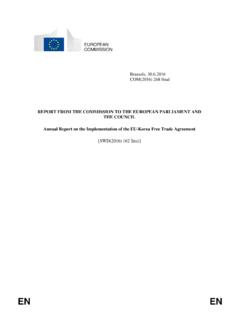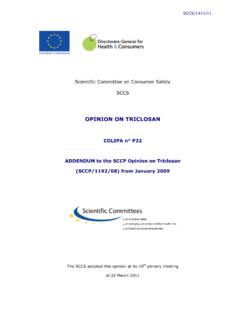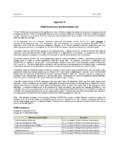Transcription of LONG-TERM TREND IN GLOBAL CO EMISSIONS - Europa
1 LONG-TERM TREND IN. GLOBAL CO2 EMISSIONS . 2011 report Background Studies LONG-TERM TREND in GLOBAL CO2 EMISSIONS 2011 report Jos Olivier, Greet Janssens-Maenhout, Jeroen Peters, Julian Wilson LONG-TERM TREND in GLOBAL CO2 EMISSIONS . 2011 report Authors Jos Olivier (PBL, IES-JRC). PBL Netherlands Environmental Assessment Agency, Greet Janssens-Maenhout (IES-JRC). The Hague, 2011; European Union, 2011 Jeroen Peters (PBL). Julian Wilson (IES-JRC). PBL publication number 500253004. JRC Technical Note number JRC65918 Responsibility ISBN 978-90-78645-68-9 PBL Netherlands Environmental Assessment Agency Institute for Environment and Sustainability (IES) of the Corresponding author: European Commission's Joint Research Centre (JRC). Jos Olivier; English-language editing Julian Wilson Graphics Marian Abels, Filip de Blois (PBL).
2 Layout Martin Middelburg (Studio RIVM). This publication can be downloaded from our website: Parts of this publication may be reproduced, providing the source is stated, in the form: Olivier, , Janssens-Maenhout, G., Peters, & J. Wilson (2011), LONG-TERM TREND in GLOBAL CO2 EMISSIONS . 2011 report, The Hague: PBL/JRC. PBL Netherlands Environmental Assessment Agency is the Dutch national institute for strategic policy analysis in the field of environment, nature and spatial planning. We contribute to improving the quality of political and administrative decision-making by conducting outlook studies, analyses and evaluations in which an integrated approach is considered paramount. Policy relevance is the prime concern in all our studies. We conduct solicited and unsolicited research that is both independent and always scientifically sound.
3 The mission of the JRC is to provide customer-driven scientific and technical support for the conception, development, implementation and monitoring of EU policies. As a service of the European Commission, the JRC functions as a reference centre of science and technology for the Union. Close to the policy-making process, it serves the common interest of the Member States, while being independent of special interests, whether private or national. Contents Summary 6. 1 Introduction 7. 2 Methodology and data sources used 8. Methodology and data sources for the 1970-2008 period 8. Methodology and data sources for 2009-2010 9. 3 Results 10. GLOBAL CO2 EMISSIONS growth in 2010 returned to the LONG-TERM historic TREND 10. Large regional differences: China and India jump by 10% and 9% while OECD and EIT countries increase by 3% 11.
4 GLOBAL EMISSIONS resumed structural growth TREND 12. trends in fossil fuel consumption 16. trends in non-energy sources 17. trends in renewable and nuclear energy sources 17. 4 Four decades in retrospect: sectoral trends in GLOBAL CO2 EMISSIONS 20. Understanding main GLOBAL trends of the past four decades 20. Industry and buildings: limited increases 20. Demand for power and transport: drivers of continuous CO2 growth 21. Shift in geographical distribution of the manufacturing industry 23. Other transport: limited growth, less than in traded volume 23. 5 Twenty Kyoto years in perspective: industrialised countries well on target 24. Industrialised countries without USA will meet collective Kyoto target of 24. Will industrialised countries with USA meet the intended Kyoto target?
5 25. Industrialised countries including the USA will meet intended Kyoto target 26. Consequences of the recession on EMISSIONS trading 26. 6 Mitigating CO2 EMISSIONS : significant changes require decades of focused policies 28. Technical means 28. Lessons learned 28. Annexes Annex 1. Method for estimating CO2 EMISSIONS trends for the period 2008-2010 30. Annex 2. Dataset on biofuel consumption for road transport per country, 2005-2010 34. Annex 3. Regional temperature anomalies in the winters of 2009 and 2010 36. References 39.. Summary After a 1% decline in 2009, GLOBAL carbon dioxide (CO2) an absolute maximum of billion ton. Increased EMISSIONS increased by more than 5% in 2010, which is energy end-use efficiency, nuclear energy and the unprecedented in the last two decades, but similar to the growing contribution from renewable energy cannot yet increase in 1976 when the GLOBAL economy was recovering compensate for the globally increasing demand for power from the first oil crisis and subsequent stock market and transport.
6 This illustrates the large and joint effort crash. CO2 EMISSIONS went up in most of the major still required for mitigating climate change. economies, led by China and India with increases of 10%. and 9% respectively. The average annual growth rate in These preliminary estimates have been made by the PBL. CO2 EMISSIONS over the last three years of the credit Netherlands Environmental Assessment Agency and the crunch, including a 1% increase in 2008 when the first European Commission's Joint Research Centre (JRC) on impacts became visible, is , almost equal to the long - the basis of energy consumption data for 2008 to 2010. term annual average of for the preceding two recently published by BP. The estimates are also based on decades back to 1990. However, most industrialised production data for cement, lime, ammonia and steel and countries have not recovered fully from their decreases in EMISSIONS per country from 1970 to 2008 from version EMISSIONS of 7 to 12% in 2009.
7 Of the EMISSIONS Database for GLOBAL Atmospheric Research (EDGAR), a joint project of JRC and PBL. The industrialised countries that have ratified the Kyoto Protocol plus the non-ratifying USA have emitted approximately less CO2 in 2010 than in 1990 and collectively remain on target to meet the original Kyoto Protocol objective of a reduction. However, there are large national differences, with for instance over the period 1990 2010 decreases in CO2 EMISSIONS in the EU. and Russia, increases in the USA and stabilisation in Japan. The efforts of the industrialised countries are increasingly hidden in the GLOBAL picture where their share of CO2 EMISSIONS has dropped from about two-thirds to less than half since 1990. Continued growth in the developing nations and economic recovery in the industrialised countries are the main reasons for a record breaking increase in 2010 in GLOBAL CO2 EMISSIONS to 6 | LONG-TERM TREND in GLOBAL CO2 EMISSIONS 2011 report E NO.
8 Introduction This paper discusses the method and results of a TREND assessment of GLOBAL CO2 EMISSIONS up to 2010 and updates the previous assessment of CO2 EMISSIONS up to and including 2009 (Olivier and Peters, 2010). This assessment includes not only fossil fuel combustion on which the BP reports are based, but also incorporates all other relevant CO2 EMISSIONS sources including flaring of waste gas during oil production, cement clinker production and other limestone uses, feedstock and other non-energy uses of fuels, and several other small sources. After a short description of the methods used (Chapter 2), we first present a summary of recent CO2. emission trends , by region and by country, and of the underlying TREND of fossil fuel use, non-fossil energy and of other CO2 sources (Chapter 3).
9 To provide a broader context of the regional trends and the achievements of the Kyoto Protocol countries we also assess the GLOBAL CO2 EMISSIONS TREND of the last four decades, where we look at emission trends per main sector rather than by country or region (Chapter 4). As 2010 is the central year of the five-year Kyoto Protocol target period of 2008- 2012, we compare the CO2 EMISSIONS TREND of industrialised countries of the last two decades with the targets set out in the protocol (Chapter 5). From the results we draw some conclusions for further mitigation of greenhouse gas EMISSIONS based on the large observed differences between countries in their energy mix and the historical rate of change in the mix (Chapter 6). 7. TWO. Methodology and data sources used This assessment excludes CO2 EMISSIONS from gas EMISSIONS per country and on a x degree grid deforestation and logging, forest and peat fires, from for all anthropogenic sources identified by the IPCC (JRC/.)
10 Post-burn decay of remaining above-ground biomass, PBL, 2011). Although the dataset under release in July 2011. and from decomposition of organic carbon in drained distinguishes about 25 sources categories, EMISSIONS are peat soils. The latter mostly affects developing countries. estimated for well over 100 detailed categories as These sources could add as much as a further 20% to identified in the Revised 1996 IPCC guidelines for GLOBAL CO2 EMISSIONS (Van der Werf et al., 2010). compilation of emission inventories (IPCC, 1996). However, this percentage is highly uncertain and varies from 15% to 35% between years. This variation is also a For fuel-related combustion EMISSIONS , the EDGAR. reason that EMISSIONS and sinks from land use, land-use dataset uses detailed international energy statistics from change and the forestry sector (LULUCF) are kept the International Energy Agency (IEA, 2010a) and a state- separate from the UN Climate Convention (UNFCCC) and of-the-art technology-based methodology, and CO2.
